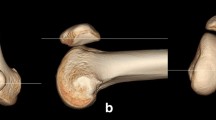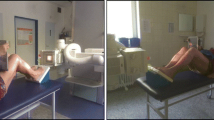Abstract
Purpose
The purpose of this study was to quantify rotational and antero-posterior instabilities using biplanar image-matching technique.
Methods
Biplanar radiographs of both chronic ACL-deficient knees and contralateral uninjured knees were taken in the pivot shift test and in the “giving way position” and lateral radiographs in stress arthrometer at 30° and 90°. Three-dimensional knee models were constructed using computed tomography. Using biplanar image-matching technique, the external rotational angle and the translation of the center of the both condyles of the femur were analyzed.
Results
The external rotation angle of geometric center axis in the pivot shift test was 16.9° ± 5.6° and 10.9° ± 7.3° (P = 0.004), and in the “giving way position” was 16.1° ± 5.7° and 10.7° ± 6.6° (P = 0.004) in ACL-deficient knees and intact knees, respectively. In the pivot shift test, the medial and the lateral femoral condylar centers of ACL-deficient knees were translated 1.2 ± 5.1 mm anteriorly and 3.9 ± 3.4 mm posteriorly, respectively, and in the “giving way position,” 2.0 ± 3.7 mm anteriorly and 2.9 ± 2.6 mm posteriorly, respectively. In stress arthrometer at 30°, the medial and the lateral femoral condylar center translated 7.1 ± 6.0 and 6.6 ± 4.8 mm posteriorly (n.s.), respectively, and at 90° translated 2.7 ± 3.4 and 2.6 ± 3.5 mm posteriorly (n.s.), respectively.
Conclusion
Rotational instability was evaluable in the pivot shift test and in the “giving way position.” Translation of both condylar centers was similar in stress arthrometry. The image-matching technique is able to quantify dynamic rotational and antero-posterior instabilities with static parameters in ACL-deficient knees.
Level of evidence
III.



Similar content being viewed by others
References
Akagi M, Mori S, Nishimura S, Nishimura A, Asano T, Hamanishi C (2005) Variability of extraarticular tibial rotation references for total knee arthroplasty. Clin Orthop Relat Res 436:172–176
Asano T, Akagi M, Nakamura T (2005) The functional flexion-extension axis of the knee corresponds to the surgical epicondylar axis: in vivo analysis using a biplanar image-matching technique. J Arthroplasty 20:1060–1067
Asano T, Akagi M, Tanaka K, Tamura J, Nakamura T (2001) In vivo three-dimensional knee kinematics using a biplanar image-matching technique. Clin Orthop Relat Res 388:157–166
Banks SA, Hodge WA (1996) Accurate measurement of three-dimensional knee replacement kinematics using single-plane fluoroscopy. IEEE Trans Biomed Eng 43:638–649
Banks SA, Markovich GD, Hodge WA (1997) In vivo kinematics of cruciate-retaining and -substituting knee arthroplasties. J Arthroplasty 12:297–304
Branch TP, Siebold R, Freedberg HI, Jacobs CA (2011) Double-bundle ACL reconstruction demonstrated superior clinical stability to single-bundle ACL reconstruction: a matched-pairs analysis of instrumented tests of tibial anterior translation and internal rotation laxity. Knee Surg Sports Traumatol Arthrosc 19:432–440
Colombet P, Robinson J, Christel P, Franceschi JP, Djian P (2007) Using navigation to measure rotation kinematics during ACL reconstruction. Clin Orthop Relat Res 454:59–65
Defrate LE, Papannagari R, Gill TJ, Moses JM, Pathare NP, Li G (2006) The 6 degrees of freedom kinematics of the knee after anterior cruciate ligament deficiency: an in vivo imaging analysis. Am J Sports Med 34:1240–1246
Dennis DA, Komistek RD, Hoff WA, Gabriel SM (1996) In vivo knee kinematics derived using an inverse perspective technique. Clin Orthop Relat Res 331:107–117
Diermann N, Schumacher T, Schanz S, Raschke MJ, Petersen W, Zantop T (2009) Rotational instability of the knee: internal tibial rotation under a simulated pivot shift test. Arch Orthop Trauma Surg 129:353–358
Ferretti A, Vadalà A, De Carli A, Argento G, Conteduca F, Severini G (2008) Minimizing internal rotation strength deficit after use of semitendinosus for anterior cruciate ligament reconstruction: a modified harvesting technique. Arthroscopy 24:786–795
Galway HR, MacIntosh DL (1980) The lateral pivot shift: a symptom and sign of anterior cruciate ligament insufficiency. Clin Orthop Relat Res 147:45–50
Georgoulis AD, Ristanis S, Chouliaras V, Moraiti C, Stergiou N (2007) Tibial rotation is not restored after ACL reconstruction with a hamstring graft. Clin Orthop Relat Res 454:89–94
Hofbauer M, Valentin P, Kdolsky R, Ostermann RC, Graf A, Figl M, Aldrian S (2010) Rotational and translational laxity after computer-navigated single- and double-bundle anterior cruciate ligament reconstruction. Knee Surg Sports Traumatol Arthrosc 18:1201–1207
Hughston JC, Andrews JR, Cross MJ, Moschi A (1976) Classification of knee ligament instabilities. Part I. The medial compartment and cruciate ligaments. J Bone Joint Surg Am 58:159–172
Ishibashi Y, Tsuda E, Fukuda A, Tsukada H, Toh S (2008) Stability evaluation of single-bundle and double-bundle reconstruction during navigated ACL reconstruction. Sports Med Arthrosc 16:77–83
Jenny JY (2009) Navigation system measures AP and rotational knee laxity in ACL replacement. Orthopedics 32:31–34
Katz JW, Fingeroth RJ (1986) The diagnostic accuracy of ruptures of the anterior cruciate ligament comparing the Lachman test, the anterior drawer sign, and the pivot shift test in acute and chronic knee injuries. Am J Sports Med 14:88–91
Kim SJ, Kim HK (1995) Reliability of the anterior drawer test, the pivot shift test, and the Lachman test. Clin Orthop Relat Res 317:237–242
Kocher MS, Tucker R, Briggs KK (2005) Relationship between subjective and objective assessment of outcomes after anterior cruciate ligament reconstruction. J Knee Surg 18:73–81
Kondo E, Yasuda K, Azuma H, Tanabe Y, Yagi T (2008) Prospective clinical comparisons of anatomic double-bundle versus single-bundle anterior cruciate ligament reconstruction procedures in 328 consecutive patients. Am J Sports Med 36:1675–1687
Kurosawa H, Walker PS, Abe S, Garg A, Hunter T (1985) Geometry and motion of the knee for implant and orthotic design. J Biomech 18:487–499
Lee HM, Cheng CK, Liau JJ (2009) Correlation between proprioception, muscle strength, knee laxity, and dynamic standing balance in patients with chronic anterior cruciate ligament deficiency. Knee 16:387–391
Lee SH, Jung YB, Jung HJ, Song KS, Ko YB (2010) Combined reconstruction for posterolateral rotatory instability with anterior cruciate ligament injuries of the knee. Knee Surg Sports Traumatol Arthrosc 18:1219–1225
Lerat JL, Moyen BL, Cladiere F, Besse JL, Abidi H (2000) Knee instability after injury to the anterior cruciate ligament. Quantification of the Lachman test. J Bone Joint Surg Br 82:42–47
Li G, Moses JM, Papannagari R, Pathare NP, DeFrate LE, Gill TJ (2006) Anterior cruciate ligament deficiency alters the in vivo motion of the tibiofemoral cartilage contact points in both the anteroposterior and mediolateral directions. J Bone Joint Surg Am 88:1826–1834
Lindström M, Felländer-Tsai L, Wredmark T, Henriksson M (2010) Adaptations of gait and muscle activation in chronic ACL deficiency. Knee Surg Sports Traumatol Arthrosc 18:106–114
Logan MC, Williams A, Lavelle J, Gedroyc W, Freeman M (2004) What really happens during the Lachman test? A dynamic mri analysis of tibiofemoral motion. Am J Sports Med 32:369–375
Markolf KL, Kochan A, Amstutz HC (1984) Measurement of knee stiffness and laxity in patients with documented absence of the anterior cruciate ligament. J Bone Joint Surg Am 66:242–252
Markolf KL, Jackson SR, McAllister DR (2010) Relationship between the pivot shift and Lachman tests: a cadaver study. J Bone Joint Surg Am 92:2067–2075
Matsumoto H (1990) Mechanism of the pivot shift. J Bone Joint Surg Br 72:816–821
Nakajima H, Kondo M, Kurosawa H, Fukubayashi T (1979) Insufficiency of the anterior cruciate ligament. Review of our 118 cases. Arch Orthop Trauma Surg 95:233–240
Nishinaka N, Tsutsui H, Mihara K, Suzuki K, Makiuchi D, Kon Y, Wright TW, Moser MW, Gamada K, Sugimoto H, Banks SA (2008) Determination of in vivo glenohumeral translation using fluoroscopy and shape-matching techniques. J Shoulder Elbow Surg 17:319–322
Okazaki K, Miura H, Matsuda S, Yasunaga T, Nakashima H, Konishi K, Iwamoto Y, Hashizume M (2007) Assessment of anterolateral rotatory instability in the anterior cruciate ligament-deficient knee using an open magnetic resonance imaging system. Am J Sports Med 35:1091–1097
Pinskerova V, Iwaki H, Freeman MA (2000) The shapes and relative movements of the femur and tibia at the knee. Orthopade 29(Suppl 1):S3–S5
Ristanis S, Stergiou N, Patras K, Vasiliadis HS, Giakas G, Georgoulis AD (2005) Excessive tibial rotation during high-demand activities is not restored by anterior cruciate ligament reconstruction. Arthroscopy 21:1323–1329
Tashiro Y, Okazaki K, Miura H, Matsuda S, Yasunaga T, Hashizume M, Nakanishi Y, Iwamoto Y (2009) Quantitative assessment of rotatory instability after anterior cruciate ligament reconstruction. Am J Sports Med 37:909–916
Tashman S, Kolowich P, Collon D, Anderson K, Anderst W (2007) Dynamic function of the ACL-reconstructed knee during running. Clin Orthop Relat Res 454:66–73
Torzilli PA, Greenberg RL, Hood RW, Pavlov H, Insall JN (1984) Measurement of anterior-posterior motion of the knee in injured patients using a biomechanical stress technique. J Bone Joint Surg Am 66:1438–1442
Tsarouhas A, Iosifidis M, Kotzamitelos D, Spyropoulos G, Tsatalas T, Giakas G (2010) Three-dimensional kinematic and kinetic analysis of knee rotational stability after single- and double-bundle anterior cruciate ligament reconstruction. Arthroscopy 26:885–893
Walker SA, Hoff W, Komistek R, Dennis D (1996) “In vivo” Pose estimation of artificial knee implants using computer vision. Biomed Sci Instrum 32:143–150
Yagi M, Kuroda R, Nagamune K, Yoshiya S, Kurosaka M (2007) Double-bundle ACL reconstruction can improve rotational stability. Clin Orthop Relat Res 454:100–107
Yamaguchi S, Gamada K, Sasho T, Kato H, Sonoda M, Banks SA (2009) In vivo kinematics of anterior cruciate ligament deficient knees during pivot and squat activities. Clin Biomech (Bristol, Avon) 24:71–76
Yamazaki J, Muneta T, Ju YJ, Sekiya I (2010) Differences in kinematics of single leg squatting between anterior cruciate ligament-injured patients and healthy controls. Knee Surg Sports Traumatol Arthrosc 18:56–63
Conflict of interest
The authors declare that they have no conflict of interest.
Author information
Authors and Affiliations
Corresponding author
Rights and permissions
About this article
Cite this article
Nakamura, S., Kobayashi, M., Asano, T. et al. Image-matching technique can detect rotational and AP instabilities in chronic ACL-deficient knees. Knee Surg Sports Traumatol Arthrosc 19 (Suppl 1), 69–76 (2011). https://doi.org/10.1007/s00167-011-1524-y
Received:
Accepted:
Published:
Issue Date:
DOI: https://doi.org/10.1007/s00167-011-1524-y




